Florida has been in the headlines the past few years for consistently ranking as the deadliest state for cyclists. This is accompanied by an unexpected finding in Palm Beach County bicycle crash data, which highlights where and why many of these accidents occur.
According to the National Highway Transportation Safety Administration’s (“NHTSA”) Traffic Safety Facts published in May 2018, Florida has the highest fatality rate for cyclists in the entire nation at 6.7 fatalities per million residents. That’s more than two-and-a-half times the national rate of 2.6 fatalities per million residents.
Only California (147) had more cycling fatalities than Florida (138). But when you consider that California’s population of 39,250,000 is nearly double that of Florida’s 20,612,000, just how treacherous Florida is for cyclists comes into sharp focus.
Texas experienced the third most cycling fatalities with 65, but has a population of 27,863,000, nearly seven million more people than Florida. As you can see, the numbers are especially startling when state-by-state comparisons put them into perspective.
Florida is the Deadliest State for Cyclists by Population
2017 Crash Data



NHTSA also provides data on U.S. cities with the highest fatality rates for cyclists. One guess in which state the top spot is located—Florida, of course. Jacksonville’s 7.95 cycling fatality rate per one million population leads the nation.
By just about any measure, Florida is home to the deadliest roads in the country for cyclists.
Related article: Most Dangerous Places for Cyclists to Ride
Unexpected Finding in Palm Beach County Bicycle Crash Data - Surprising Revelation
As an avid cyclist and native Floridian, I’m deeply troubled by the general state of affairs for cyclists on Florida’s roads, and as a resident of Palm Beach County for the past 40 years, I’m especially concerned about what’s happening on the streets right here where I live, work, and ride.
To get a better understanding of the situation, I decided to examine the most recent cycling crash data for Palm Beach County published by the Florida Department of Transportation in its 2017 Final Report (“Report”), Statewide Analysis of Bicycle Crashes, together with the Palm Beach Metropolitan Planning Organization’s 2017 Pedestrian and Bicycle Safety Study (“Study”).
What I found surprised me. It wasn’t the sheer number of bike crashes happening in Palm Beach County. What shocked me was WHERE they are occurring WHO was being hit! It was not who I assumed.
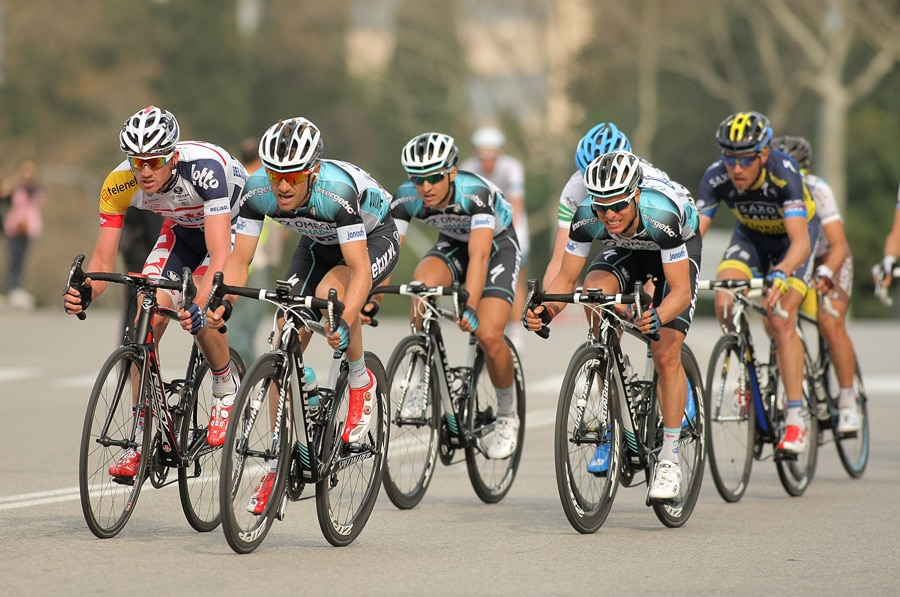
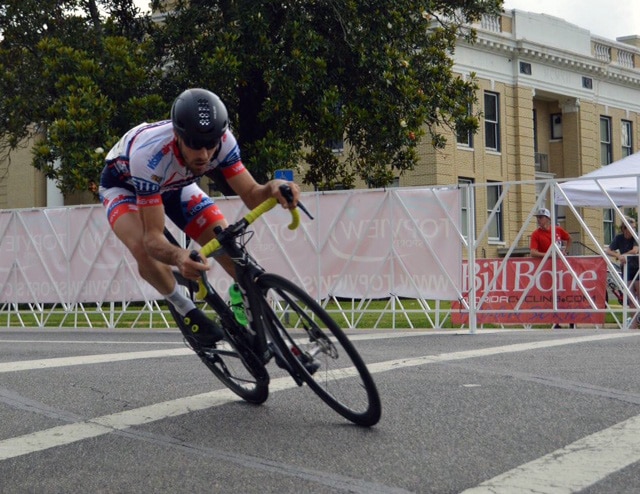
That is, of Palm Beach County’s top ten “high crash corridors” identified in the Study, only one of them is an area where so-called “road cyclists” regularly ride—Ocean Boulevard from Linton Boulevard to Thomas Street.
Road cyclists are the type most people think of when picturing cyclists riding on the roads along with motor vehicles. You know, the ones in fluorescent spandex bodysuits on carbon fiber bikes costing thousand of dollars and often riding in groups to the endless frustration of motorists who get stuck behind them.
Related article: Top 7 Mental Health Benefits of Cycling
The other nine high-crash corridors in the county aren’t areas where road cyclists typically choose to ride. They’re located in the following areas in Palm Beach County.
- Federal Highway from Camino Real to Glades Road
- Atlantic Avenue from Barwick Road to Ocean Boulevard
- Lantana Road from Jog Road to Military Trail
- Lake Worth Road from Jog Road to Lakeside Drive
- Military Trail from Melaleuca Lane to Okeechobee Boulevard
- Okeechobee Boulevard from Drexel Road to Palm Beach Lakes Boulevard
- North Dixie Highway from Okeechobee Boulevard to 45th Street
- Northlake Boulevard from Military Trail to Old Dixie Highway
- Indiantown Road from Central Boulevard to Alt A1A
These nine high crash corridors aren’t along stretches of streets favored by road cyclists. Instead, they’re areas where everyday people ride.
People in these locations generally cycle as a means of transportation because they either don’t have a car or choose to cycle based on environmental concerns.
They’re cycling to work or school and running errands; they’re cycling out of necessity, not for sport or recreation.
Palm Beach County Bike Crash Hotspots Map
Perception Versus Reality:
Everyday People Most Often Victim of Bike Crashes
The crash data from the Report and Study tell us that the reality is actually contrary to the widely held perception of the type of cyclist involved in most bike crashes.
It’s not road cyclists who are being injured and killed at alarmingly high rates in Palm Beach County; instead, the overwhelming majority of crashes, injuries, and fatalities involve everyday people commuting and running errands on their bike out of necessity or principle.
It's not "road cyclists" who are being injured on Palm Beach County roads. It is everyday people commuting and running errands who are being run over and killed by motorists.
This revelation is noteworthy because hopefully, it’ll help change public perception about cycling crashes in Palm Beach County, which ideally will, in turn, generate greater public support for the county to implement the numerous, sensible safety initiatives recommended in the Report and Study. Fair or not, everyday cyclists are a more sympathetic group than road cyclists.
Let’s face it, the truth is road cyclists are not a very sympathetic group in the eyes of the general public. In fact, many motorists display a callous indifference towards the safety and well-being of road cyclists, both in word and deed.
So there is a lack of public support for the county to spend public funds on bicycle-friendly infrastructure improvements in an effort to decrease the number of cycling crashes.
Nevertheless, there is an urgent need to reduce the number of crashes in Palm Beach County, which ranks fourth in the state in the number of crashes according to data contained in the Report.
Related article: Florida Cycling’s Terrifying Future
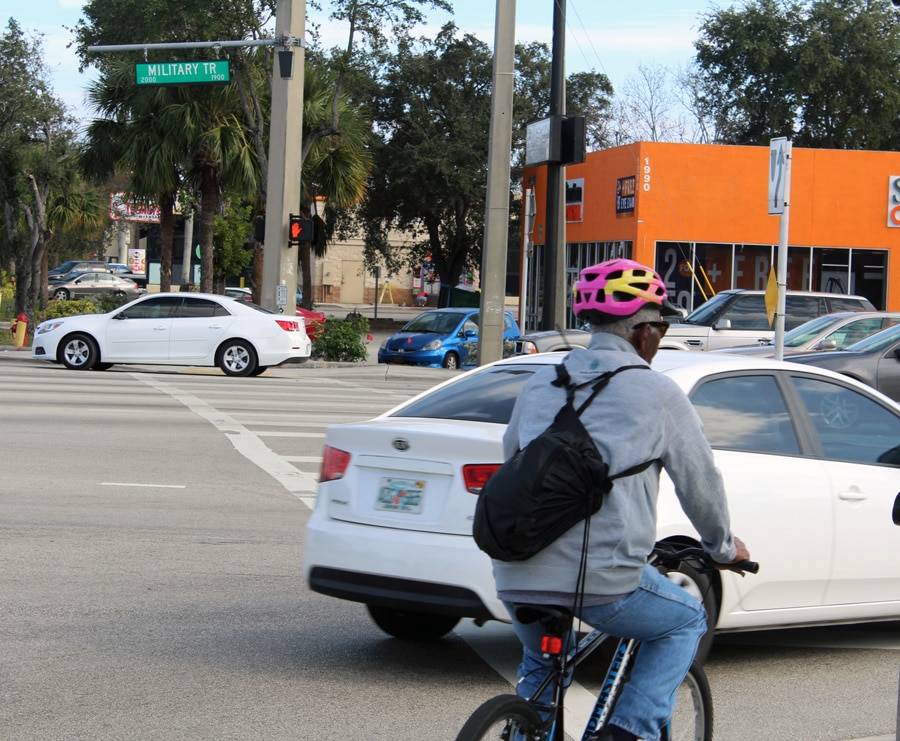


Bicyclist riding in traffic on Okeechobee Blvd.
It’s no secret that road cyclists and motorists have an openly antagonistic relationship. The frustration and enmity run in both directions.
Motorists accuse cyclists of flouting traffic laws and norms, posing a danger to others on the road, causing gridlock and backups, and not belonging on the streets at all.
Road cyclists counter that motorists don’t even know the traffic laws pertaining to cyclists (yes, bicycles are legally allowed on public roads, and motor vehicles must allow at least three feet of clearance when passing), fail to look for cyclists as they do for vehicles and pedestrians, and don’t extend any patience or common courtesy towards cyclists.
Related article: Pros and Cons of Biking to Work
The Rise of Severe Bicycle Crashes in Florida’s Urban Areas
Recent reports show a troubling rise in collisions involving cyclists across Florida, particularly in urban areas where traffic signals, signs, and the posted speed limit often fail to prevent tragic incidents.
Data reveals that two-thirds of these crashes occur on busy corridors where everyday residents commute, not just recreational riders. In counties like Miami-Dade and Broward, the severity of these crashes continues to increase, with many cyclists unable to survive after being struck at night or during poor weather.
Police investigations frequently identify distracted drivers and roadway design flaws as major contributors, and attorneys representing injured riders or grieving families emphasize the urgent need for reliable safety measures to protect their clients on behalf of the community.
Legal Support and Accountability After a Cycling Crash
When a cyclist is struck, police conduct an investigation to determine fault, but many families are left struggling with the rest of the aftermath. For those who did not survive, compassionate legal attorneys often step in on behalf of victims to hold negligent motorists accountable.
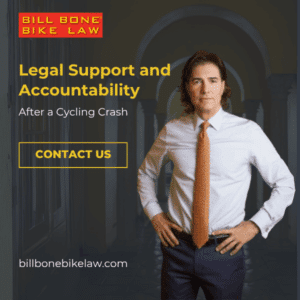 These professionals work to secure fair compensation for clients while ensuring reliable advocacy throughout the legal process.
These professionals work to secure fair compensation for clients while ensuring reliable advocacy throughout the legal process.
Unfortunately, not every crash scene receives the attention it deserves, and too often, warning signs of dangerous road conditions are ignored until tragedy strikes.
Compared with motorists, cyclists lack the protection to withstand fatal crashes, making it critical to push for stronger infrastructure, better enforcement, and safer roads for all.
As both a road cyclist and motorist, I see some merit in both points of view.
But motorists’ complaints and hostility, for the most part, aren’t directed toward everyday bicyclists.
So, with the revelation about the type of bicyclist overwhelmingly involved in crashes and being injured or killed in Palm Beach County, it is my hope that public sentiment will begin to shift from indifference to immediate action on this issue.
Related article: Muscle Groups Targeted and Used While Cycling
No cyclist should have to literally put his or her life at risk by simply riding a bicycle on the street, regardless of the purpose for cycling.
That’s something everyone can agree upon. The unexpected finding in palm beach county bicycle crash data reinforces why this issue demands urgent attention.
Let me know your thoughts in the comments below..


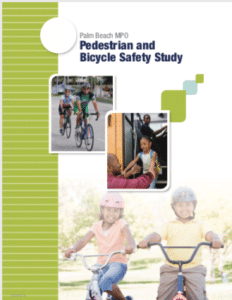
Great discovery Bill!
The general motorist population is currently desensitized. There is no emotional connection or empathy between the humans operating thousands of pounds of speeding metal and the [mother,father,daughter,son,brother,etc] exposed and vulnerable bicycling to the grocery store.
Motor-centric infrastructure and automobile advertising has given motorists a sense of empowerment and entitlement when it comes to sharing roads and understanding the ever-changing laws for auto, bike, ped. How do we shift this mentality? How do we build smarter safer infrastructure, “complete streets”, or segregated pathways that everyone can use without fearing for their lives? How to we adapt MISSION ZERO for the entire state? Florida is such a beautiful state in which to bicycle! Hope we can solve this problem during my lifetime.
This was most informative and eye opening! Thank you for bringing these amazing and sad statistics to life. Hopefully, the future will be brighter for the bike rider.
Wow thank you so much Bill!! I have been riding around Fort Pierce Florida and the main thing I find dangerous his the bike Lanes that have debris or Sand and Gravel at least covering more than half of the lane so you are forced to get closer to the traffic! And or very bumpy roads that need Paving and the road marking lines painted! I have been using my scooter also and a nail was in my tire that put me in danger of crashing at 50 miles an hour road debris is in need of being swept off or cleaned off our roadways and bike paths especially metal screws and nails like roofing nails and drywall screws maybe tougher laws on people transporting these types of cargo as far as containment! So they don’t just fall off of their trailers and truck beds! God bless you Bill thanks for speaking out on this matter because a lot of drivers out there don’t realize bicycles do have the right to be on the road and should be abiding buy the regular traffic laws! But where one of the first methods of transportation and need to be respected better on the roads! Thank you so much Bill! Happy cycling!
Not very enlightening conclusions about cause or prevention.
Identifying dangerous segments is helpful.
Now we have to ask is there something specific about the killing zones that is a factor? Lack of bike lanes? Lack of pedestrian crosswalks that allow sidewalk rides to cross junctions? Difficulty merging in high speed traffic to make turns?
I would ask if time of day, use of bike lights, or riding in groups were a factor in the crashes.
Most accidents seem to be car on solo cyclist. with the collision being ruled “just an accident” because the driver said “I did not see them.”
From personal experience I have come to believe that the larger the group of riders the more visible the cyclists are.
large group rides are more often difficult for motorists to pass, and cause traffic to slow down, which may be a good thing.
Bill, interesting article. I totally agree. Let me add what I have seen as a very careful driver. Looking ahead at the drivers, I see so many cars NOT adhering to their car lanes but utilizing a portion of the bike lanes. I would therefore assume that this is a driving habit and dangerous when bikers occupy their proper lane!
This is a sad reality.
Palm Beach County Commissioners can help by adopting complete street policies and NACTO standards in their comprehensive plan and all road designs. These are easy fixes to help make #safestreets for all.